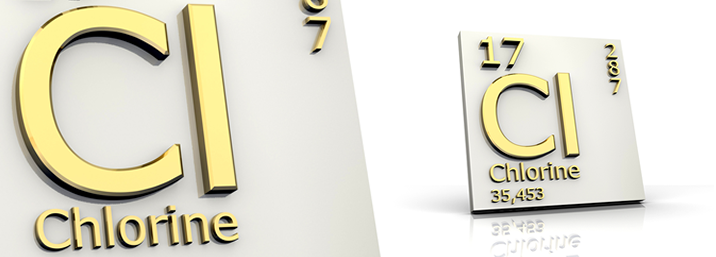Chlorine Testing

Chlorine Determination via Schoniger Combustion:
The solid sample is weighed into ashless paper and inserted into a custom made Platinum stopper. The stopper is fitted with a flask that is charged with the appropriate reactants and oxygen. On combustion, the chlorine present is trapped as HCl.
The HCl gases are absorbed on the liquids and the resulting liquid is then removed and titrated with a standardized solution of Ag-perchlorate in I-proh. Bromine and Iodine react in the same manner; therefore these do present interferences. Hg is also an interference.
The most common standard for this determination is Para-Cl Benzoic Acid available through the NIST. There are others that may be used on occasion.
The preceding is a brief description of our techniques used in chlorine determination.
Chlorine and Bromine can be done together providing a complete molecular formula is provided by the submitter.
What is Chlorine?
Atomic weight 45.35, Atomic Number 17, Melting Point -101.50 C, Boiling Point -34.04 C.
Chlorine (from the Greek χλωρóς chloros, meaning “pale green”), is the chemical element with atomic number 17 and symbol Cl. It is a halogen, found in the periodic table in group 17. As the chloride ion, which is part of common salt and other compounds, it is abundant in nature and necessary to most forms of life, including humans.
In its elemental form under standard conditions, it is a pale green gas about 2.5 times as dense as air. It has a disagreeable suffocating odor and is poisonous. Chlorine is a powerful oxidant and is used in bleaching and disinfectants.
Chlorine gas is diatomic with the formula Cl2. It combines readily with nearly all other elements, although it is not as extremely reactive as fluorine. At 10 °C one liter of water dissolves 3.10 liters of gaseous chlorine and at 30 °C only 1.77 liters.
This element is a member of the salt-forming halogen series and is extracted from chlorides through oxidation often by electrolysis. As the chloride ion, Cl–, it is also the most abundant dissolved species in ocean water.
Relevant sites for Chlorine:
When we think of chlorine, we often relate it to the salt used in food … Cl connected to C atoms in organic compounds exhibits intense low-energy features ..
USGS CIRC 1157 subpage: MAJOR ISSUES AND FINDINGS–Other Organic…
These organic compounds (chemical compounds containing the element carbon) include organochlorine compounds (compounds with both carbon and chlorine)…




